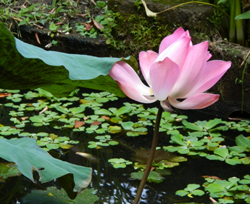 TO BALI AND BACK: Batik Study tour to Bali, 2013 TO BALI AND BACK: Batik Study tour to Bali, 2013
—Bunny Bowen
The following notes recount my recent textile study tour to Bali. Accompanied by four other artists, I joined longtime friend and mentor Kiranada in the village of Penestanan, above Ubud, to learn a bit about the batik tradition there.
First night in Penestanan
As the evening deepened, I retired to the four poster bed, drawing down the gauzy white mosquito netting.
I felt very small; my mattress became the young green seed head of a lotus blossom, suspended above the black pond, pink petals closed around me in the dark. Life pulsated as thousands of frogs, crickets, and geckos nearly drowned out the soft gamelan and drums wafting across the newly planted rice paddies.
Then, sound sleep… eventually interrupted by the crow of the first rooster to sense the possibility of a new day. Though it was still quite dark, he was gradually joined by dozens of others, who woke the doves, the cicadas, the Bali dogs, and me.
Breakfast in the compound
Joined by my fellow travelers around a massive teak table under a generous pavilion, I tasted my first dark, thick “Bali kopi.” It went straight into my bloodstream, helping to relieve the jet lag from the thirty-hour journey and the fourteen-hour time warp across the International Date Line.
We feasted on fresh papaya, pineapple, nasi goreng, banana pancakes, and giant boiled eggs prepared by the ever-cheerful Ketut, sister of our hostess Madé. A moss-encrusted Ganesha peered down on us through the smoke of sandalwood incense.
So began the first of ten days in the Santra Putra compound of artist Wayan Karja
Karja soon met with us in his airy studio, first recounting his own journey from traditional representational imagery to his internationally known abstract style. He explained the Balinese palette: white symbolizes the east, sunrise, peace, god. The south color is red, for Brahma, the creator. West is yellow, the setting sun, for Vishnu, a temple color. North, the direction of Bali’s sacred volcano, Gunung Agung, is black or blue, Shiva. |

|
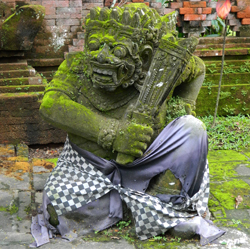 |
Poleng, the ubiquitous black-and-white checkered cloth draped over temple figures and other sacred spaces symbolizes the balance between good and evil, light and dark. It seems to come from the Buddhist foundation which underlies the Hindu religion as practiced in Bali. Karja’s sense is that most of the time we live in the grey areas in between. |
Our next days were filled with visits to museums and galleries in Ubud, a textile history presentation by Threads of Life founder William Ingram, and sketching at the Agung Rai Museum of Art. We spent two days in the indigo batik workshop owned by Pak Tjok in nearby Pejeng, standing over 24-inch wide pans filled with smoking wax, learning the basics of tjap stamping and tjanting drawing. (see photos in left column)
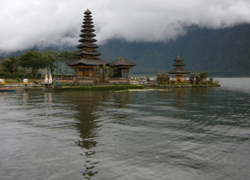 There was a refreshing day-trip to scenic Lake Bratan, which is graced by the tall pagoda pictured on the 50,000 rupiah banknote. Our driver, Gusti Sutarja, treated us to a stop at a coffee plantation and delivered us to a lovely warung overlooking green rice paddies. After the steaming heat of Ubud, we enjoyed the cool mist and breezes of the highlands. There was a refreshing day-trip to scenic Lake Bratan, which is graced by the tall pagoda pictured on the 50,000 rupiah banknote. Our driver, Gusti Sutarja, treated us to a stop at a coffee plantation and delivered us to a lovely warung overlooking green rice paddies. After the steaming heat of Ubud, we enjoyed the cool mist and breezes of the highlands.
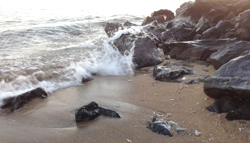 Gusti’s skill at maneuvering the winding roads jammed with motor scooters, trucks, chickens, and dogs was impressive. He later took us to Amed, where we spent two days overlooking a volcanic beach at the foot of sacred Mt. Agung. Gusti’s skill at maneuvering the winding roads jammed with motor scooters, trucks, chickens, and dogs was impressive. He later took us to Amed, where we spent two days overlooking a volcanic beach at the foot of sacred Mt. Agung.
Our return trip to Ubud, on the day before the Balinese New Year, Nyepi, included views of giant grotesque ogoh-ogoh (Hindu goblins). Built annually by each banjar (neighborhood), these were to be paraded through the streets and then burned in a spectacular night party. As many main streets were closed by noon, Gusti had to get creative as he threaded his Toyota Kijang though tiny back alleyways along our route.
Safely back at our cottage in Penestanan, we joined crowds of Balinese who were stocking up on food at the local supermarket. There was to be no cooking the next day on Nyepi, no fires nor electricity, no speaking, and definitely no going out of the house. Streets were to be empty, and the airport in Denpasar was closed. Should goblins still be about, they were to think nobody was home and go away. |
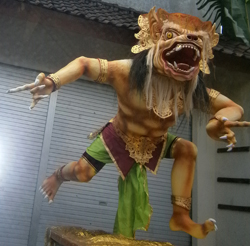 |
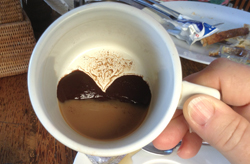 Indeed, when we met the next morning for a breakfast, we ate the meal prepared the night before in silence. At least there was strong Bali kopi! Indeed, when we met the next morning for a breakfast, we ate the meal prepared the night before in silence. At least there was strong Bali kopi!
We followed the custom of quiet contemplation, retiring at sunset and keeping the dark silence until the next day ... our last full day in Bali.
We made our last purchases, packed, unpacked, then repacked.
It had seemed to go so quickly, though at times the oppressive heat made it feel as though life were to be forever suspended in a soggy stupor.
The thirty-eight hour trip home was brightened by the company of fellow travelers, Vivian and Katalin. Marjorie and Lynda had continued on with further adventures, but I was ready to get back to Placitas.
I thank my generous friend and planner of this great adventure, Kiranada, whose global connections with other artists of the wax-resist persuasion have once again taken me to the other side of the world and back.
Originally published in the Sandoval Signpost, Placitas, New Mexico, April 2013.
|

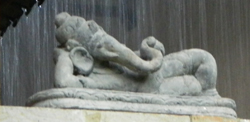
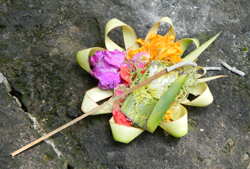
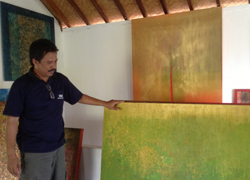
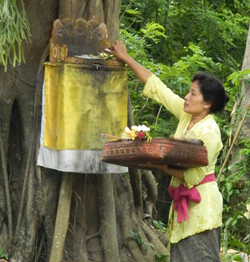
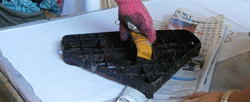
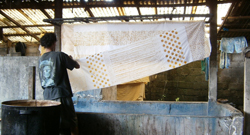
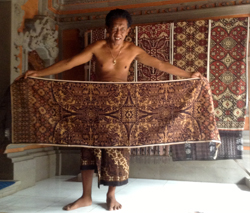
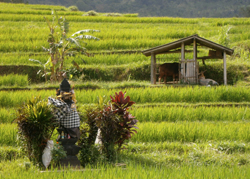
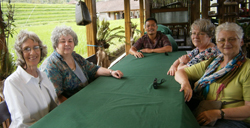

 TO BALI AND BACK: Batik Study tour to Bali, 2013
TO BALI AND BACK: Batik Study tour to Bali, 2013


 There was a refreshing day-trip to scenic Lake Bratan, which is graced by the tall pagoda pictured on the 50,000 rupiah banknote. Our driver,
There was a refreshing day-trip to scenic Lake Bratan, which is graced by the tall pagoda pictured on the 50,000 rupiah banknote. Our driver,  Gusti’s skill at maneuvering the winding roads jammed with motor scooters, trucks, chickens, and dogs was impressive. He later took us to Amed, where we spent two days overlooking a volcanic beach at the foot of sacred Mt. Agung.
Gusti’s skill at maneuvering the winding roads jammed with motor scooters, trucks, chickens, and dogs was impressive. He later took us to Amed, where we spent two days overlooking a volcanic beach at the foot of sacred Mt. Agung.
 Indeed, when we met the next morning for a breakfast, we ate the meal prepared the night before in silence. At least there was strong Bali kopi!
Indeed, when we met the next morning for a breakfast, we ate the meal prepared the night before in silence. At least there was strong Bali kopi!